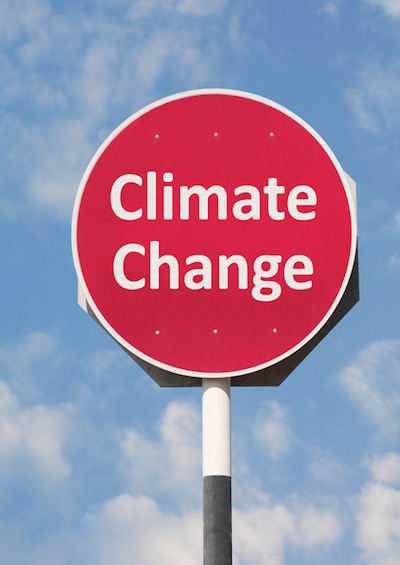Pricing the Risk of Climate Change
Why U.S. politicians must learn about dealing with reality.
November 13, 2014

Politicians and pundits on the American right wing have started to respond almost ritualistically to questions about climate change with the words, “I’m not a scientist.”
Forget for a moment that this is an idiotic construct – of course they aren’t scientists, they’re politicians or pundits. The transparent intent is for hardened climate change deniers to appear more reasonable.
They have gone from rejecting the whole concept of global warming out of hand to merely evading the issue — “I’m not a scientist!”
In the weird world of American politics, the new battle cry, “I’m not a scientist” may nonetheless represent an ideological “first blink” – a tacit admission that there may be something to all this “fake science” after all.
To see how and why, it helps to focus on real-life actions rather than rhetoric. In particular, look at a classic conservative business constituency – insurance companies.
I’m not a scientist, but I am an insurance company!
Insurance premiums do not make moral judgments. They are dispassionate – some might use the term “cold-blooded” – in their determinations of risk.
And that is what makes the insurance industry’s outlook on climate change so important, especially in the United States, which is unique among developed countries in the number and ferocity of its climate change deniers.
For these insurers, climate change is exclusively a matter of how much to charge for underwriting the risk – not some esoteric debate involving global conspiracies of scientists.
Inevitably, insurance rates are based on actuarial evidence of historic patterns of risk. But the global insurance industry – with the big re-insurers in the lead — is now saying with more than a little consistency that historic weather patterns are no longer relevant.
In short, climate change is demanding new risk assumptions.
Property protection and climate change
Of the many risks related to climate change, property risk is the most clearly identifiable – a reality close to the hearts of many conservatives.
Anyone with an even casual interest in the news must acknowledge that weather events seem to be occurring both with increased frequency and greater intensity. For the world’s insurers, however, this is more than a casual observation.
The Geneva Association, a re-insurance trade organization, reported on the implications of rising ocean temperatures in 2013.
Based on clear and well-documented statistics, their recommendation was for re-insurers to base premiums not on actuarial evidence, but on climate change models. In other words, they recommend reliance on the very models that climate change deniers try so vigorously to discredit.
I’m not a scientist, but I think I get the difference!
Underpinning the insurance industry’s view of anthropogenic climate change is science. Even though insurers are not scientists, they seem able to grasp not only the financial implications of climate change, but also the cause.
They point out that weather and climate are different. Weather is what it was like outside when you got out of bed yesterday. Climate is the amalgamation of all those morning readings over significant time frames across all latitudes and longitudes on the face of the earth.
Scientists have used those numbers to produce models that assess the contributory factors to climate change, which include measureable influences of “internal variability” such as,
2. The Atlantic Multidecadal Oscillation (AMO)
3. The Pacific Decadal Oscillation (PDO)
and dozens of similar oscillating patterns. They also recognize the impact of volcanic and other geological events on climate.
The impacts of these conditions are measurable with a high degree of precision. And when their impacts are measured over protracted time frames, something striking pops out.
The average temperature on earth has risen at an accelerating pace over the past forty years — .52 degrees Celsius (1 degree Fahrenheit). Based on the influence of internal variability, long-term average temperatures should not have changed at all, aside from short-term spikes in volatility caused by major oscillations and geological events.
It is only when you include the impact of anthropogenic effects on climate that you find actual temperature readings matching precisely the climate prediction models now being employed by the insurance industry.
I’m not a scientist, but 40 years is a good track record!
These models have been employed in progressively more sophisticated iterations over the past 100 years. And for the past 40 years, the anthropogenic climate change models have been better predictors of global climate trends than risk models based entirely on internal variability.
In the world of finance, an impeccable 40-year track record would make you, well, God! Or Warren Buffet!
Mind you, the view of the insurance companies is not that of a bunch of environmentalists. It is the view of folks who insure risk in order to make a profit.
Their models say that global warming does not necessarily mean progressively milder winters, hotter summers and warmer springs and autumns.
Rather, they show changes in ocean temperatures, including surface temperatures as well as the deep ocean currents that recirculate weather patterns across hemispheres.
Importantly, this results in changes in the moisture content and wind speed of storms. It produces floods, droughts, heat waves and freezes.
That insight is unfortunately completely lost on Senator James Inhofe – the likely new Chairman of the U.S. Senate Committee on the Environment.
In a breathtaking display of blind ignorance, he stood for a photo op in front of mounds of plowed snow in Washington, D.C. in 2010, thinking he was providing graphic evidence that global warming was a hoax. In fact, he was showcasing exactly why global warming is real: Bigger storms with higher moisture content!
It’s not just insurance companies, the military, too
But insurers are not the only ones to accept climate change as a reality. The U.S. military is planning and budgeting for geopolitical dislocations as well.
It has great concerns about adverse events caused by distortions to historic weather patterns, including possibilities for insect infestations, famines, pandemics, food riots, civil wars and mass migrations.
Public utilities, too, are grappling with how to maintain and effectively transmit power during peak demand periods caused by extreme temperatures. In countries with above- ground power transmission networks — like the United States — utilities must also plan for increasing levels of storm damage, including widespread and prolonged power outages.
By the same token, municipalities must not only repair infrastructure damage caused by storms. They must also bear the financial burden of planning new infrastructure to prevent storm damage. This includes improvements to sewer systems, the construction of sea walls and the establishment of effective storm shelter systems.
Of even greater significance, a 2003 heat wave that blanketed France killed over 14,000. In Moscow in 2010, 11,000 died from a bad summer heat wave. In Chicago in 1995, more than 700 died. As a result these climate events, health systems around the world are starting to make provision for more to come.
I’m not a scientist, but this is going to cost money!
For the insurance industry, climate change is real. For the insured, this realism will translate into progressively higher premiums that are just as real.
But higher premiums are just the start. At the end of the day, folks everywhere will all have to pick up the tab for the inefficient use of energy derived from fossil fuels.
That tab will list higher utility bills, higher taxes and higher health care costs, among hundreds of other entrees, appetizers and deserts.
Perhaps this type of evidence is finally sinking in for climate change deniers when they say, “I’m not a scientist.”
Perhaps they will start to see smart people from different disciplines recognize climate change as fact, not some oddball theory or global conspiracy.
Or maybe not! Maybe their real mission in life is to be deniers of scientific realities, if not modernity itself. Maybe their only calling is to defend the interests of America’s oil patch, no matter the consequences or the risks.
Takeaways
What are Republicans to do when insurance companies and the US military share the same view on climate change?
The US military is planning and budgeting for geopolitical dislocations as a result of climate change.
Global warming does not necessarily mean ever milder winters, hotter summers and warmer springs and autumns.
Even though insurers are not scientists, they grasp the financial implications of climate change – and the cause.

